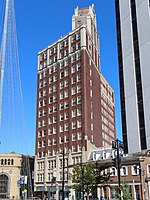Sibley's, Lindsay and Curr Building
Buildings and structures under construction in the United StatesChicago school architecture in New York (state)Clock towers in New York (state)Commercial buildings completed in 1904Commercial buildings in Rochester, New York ... and 5 more
Commercial buildings on the National Register of Historic Places in New York (state)Defunct department stores based in New York StateMixed-use developments in New York (state)National Register of Historic Places in Rochester, New YorkRenaissance Revival architecture in New York (state)

Sibley's, Lindsay and Curr Building is a historic commercial building located at Rochester in Monroe County, New York. It was designed by noted Rochester architect J. Foster Warner and built for Sibley's in 1904. The original wing of the building was constructed in 1906 as a five-story, Chicago school style skeletal steel building sheathed in brown Roman brick with deeply set Chicago style windows, topped by a clock tower with Baroque and Renaissance style details. Additions were made to the building in 1911 and 1924, including a 12-story tower section.: 74–75, 78–79 It was listed on the National Register of Historic Places in 2014.
Excerpt from the Wikipedia article Sibley's, Lindsay and Curr Building (License: CC BY-SA 3.0, Authors, Images).Sibley's, Lindsay and Curr Building
North Clinton Avenue, City of Rochester
Geographical coordinates (GPS) Address Nearby Places Show on map
Geographical coordinates (GPS)
| Latitude | Longitude |
|---|---|
| N 43.158055555556 ° | E -77.605833333333 ° |
Address
Sibley Square
North Clinton Avenue 250
14604 City of Rochester
New York, United States
Open on Google Maps










